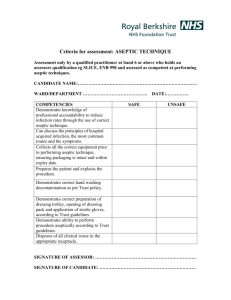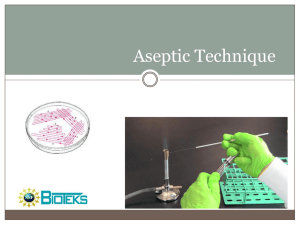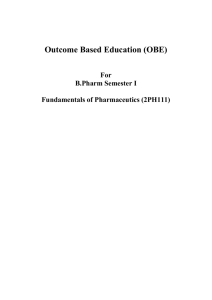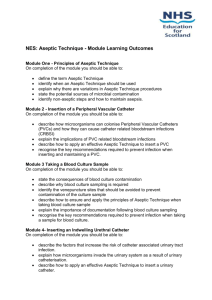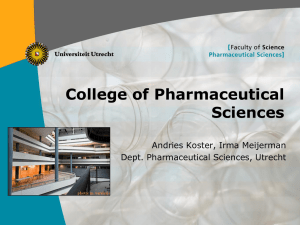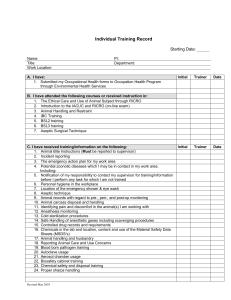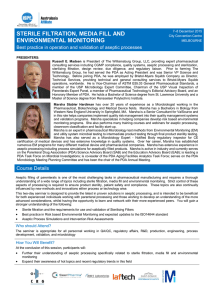Outcome Based Education (OBE)
advertisement
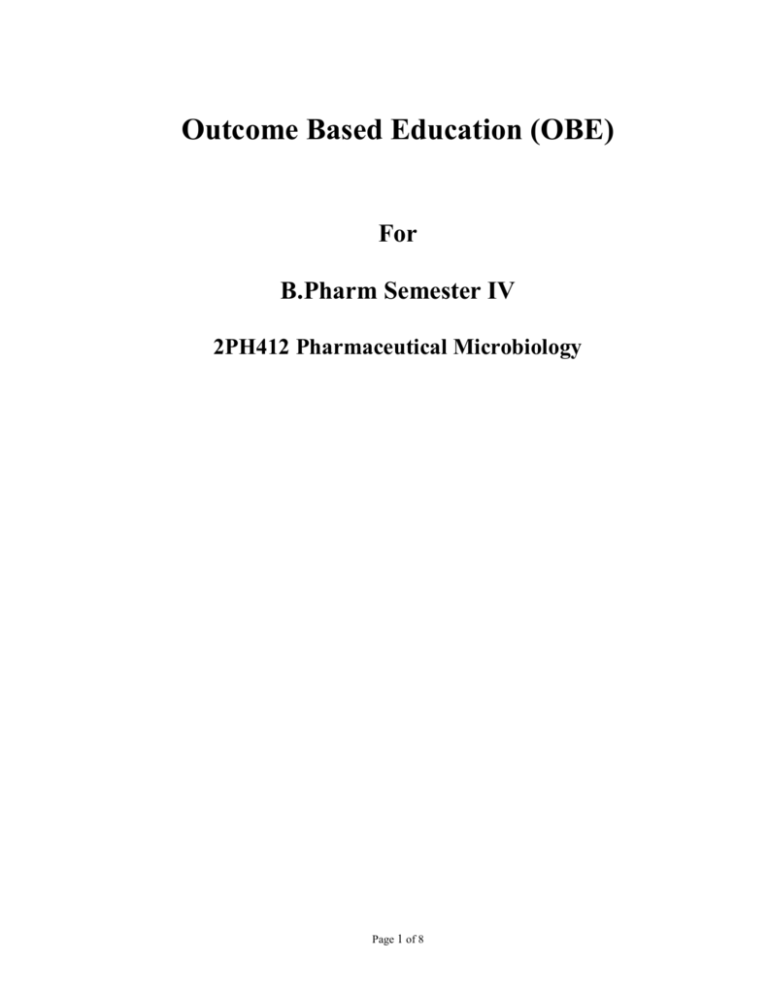
Outcome Based Education (OBE) For B.Pharm Semester IV 2PH412 Pharmaceutical Microbiology Page 1 of 8 GRADUATE ATTRIBUTES 1. In depth knowledge of pharmacy 2. Analytical/ bio statistical capability for problem solving 3. Designing and executing pharmaceutical problems 4. Use of modern instruments and soft wares 5. Professional ethics and practices 6. Communication, Team work and leader ship 7. Capability of managing healthcare issues 8. Critical thinking Page 2 of 8 B.PHARM PROGRAMME EDUCATIONAL OBJECTIVES (PEO’s) PEO No. Program Educational Objectives PEO1 Knowledge of the scope of pharmacist and understand the responsibilities and functions of pharmacist. PEO2 Development of understanding of various subjects related to pharmaceutical sciences. PEO3 Hands on experience of various techniques, instrumentation and softwares. PEO4 Ability to analyze, interpret, write and express the data scientifically. PEO5 Have highest standards of professional ethics and moral values. PEO6 Have good research attitude and meet global demands. Page 3 of 8 B.PHARM PROGRAME LEARNING OUTCOMES No. Program Learning Outcomes Students will be able PLO1 To understand basic concepts of Pharmaceutical Sciences PLO2 To acquire technical expertise and in-depth knowledge of pharmacy profession PLO3 To analyze regulatory, legal and ethical issues related to pharmaceutical industries PLO4 To acquire hand-on training on pharmaceutical instruments, equipment, software PLO5 To work has paramedical team member for health care management PLO6 To explore opportunities for higher studies and research To know the scope of pharmacist and understand the responsibilities and functions PLO7 of pharmacist as a community and industrial pharmacist PLO8 To develop higher standards of professional ethics and moral values Page 4 of 8 Mapping of Course Learning Outcomes of B.Pharm Sem IV Course with Programme Learning Outcomes Pharmaceutical Microbiology (2PH412) CLO’s: 1. Develop expertise in identification, cultivation and counting of microorganisms, preparation and sterilization of bacterial culture, various staining techniques, aseptic processing etc. 2. Learn various disinfection and sterilization techniques and their evaluation processes, hands on various lab instruments like hot air oven, autoclave, incubator, laminar air flow unit, centrifuge, distillation assembly etc. 3. Evaluate the sterility testing, microbial assays, pharmacopoeial standards of sterilization process. Pharm. Micro CLO1 PLO1 PLO2 CLO2 CLO3 PLO3 PLO4 Page 5 of 8 PLO5 PLO6 PLO7 PLO8 Method of Assessment B.Pharm Sem IV Curriculum Map of Programme Learning Outcomes Course Name Pharm. Micro. PLO1 PLO2 Class Tests – Lab Exam / Moodle Assignments / Chart Making PL O3 PLO4 PLO5 PLO6 PLO7 PLO8 --- Lab Exam Assignments / Group activities / Class Presentation s --- End Semeste r Exam --- List of Possible Assessment Methods: Direct Methods End Semester Examination Class Tests: Online (MCQ), Short Answer Lab Exam Class Presentations Assignments / Tutorials Projects / Group Activities Simulation / Animations / Model / Chart Making Case Study Indirect Methods Surveys (Employer, Faculty, etc.) Interviews by Industry Experts Feedback by the Stakeholders Competitive Exams Page 6 of 8 NIRMA UNIVERSITY B.Pharm Semester IV (2014-2015) Evaluation of the practical component of students with the help of RUBRIC COURSE NAME: 2PH412 COURSE CODE: Pharmaceutical Microbiology Categories 1. Skill to handle microscope and identify cell structures with proper focus Indicators: Handling of microscope with proper care, preparation of slides, mounting of slides on platform, adjusting lens and proper focusing in identification of cell structures 2. Expertise and understanding about working in aseptic area Indicators: Knowledge related gowning, entry and exit of aseptic area, maintaining working environment during aseptic processing, entry and exit of culture, media, glass wares, handling of LAF unit, incubator, and knowledge about maintaining sterilization inside aseptic area 3. Clarity of concept during viva-voce Indicator: Concept about microbial kingdom, taxonomy, staining techniques, microscopic techniques, nutrition, isolation, cultivation of microorganisms, aseptic techniques, information about sterilization, sterility testing, microbial assays, IP, BP and USP pharmacopeial standards for sterilization etc. 4. Overall attendance / regularity Indicator: Regularity in attending all the practical sessions and performing all given routine tasks 5. Journal writing skills Indicator: Well-maintained journal with writing, drawing and presenting skills Indicator Skill to handle microscope and identify cell structure with proper focus Level -4 Level -3 Level -2 Level -1 (Excellent) (Good) (Average) (Unsatisfactory) Good hands on microscope handling and identify majority of microorganisms Average microscope handling capacity and identify very few microorganisms Poor microscope handling and difficult to identify simple cell structures of microogranisms Acceptable Average Poor in aseptic Expertise in microscope handling and identification of various cell structures of given microorganism samples Thoroughly Page 7 of 8 Expertise and understanding about working in aseptic area Clarity of concepts during Viva voce Overall attendance/ Regularity Journal Writing skills know how to work in aseptic environment and performing all aseptic processes with outstanding expertise very clear concepts regarding the microorganisms and their characteristics, staining techniques, aseptic technqiues, and cultivation techniques etc. attended practiclas knowledge about how to work in aseptic technqiues and good performace in aseptic processes knowledge about how to work and perfrom aseptic techniques working, no idea about how to perform aseptic experiments average few concepts understanding, not clear many concepts not clear very poor understanding and concepts not clear very poor all absent in 1 or 2 absent in 3 or 4 attendance in practicals practicals practicals very neat journal with excellent writing, presenting and drawing skills Aceeptable average writing writing, and understanding drawing and skills, drawing presenting and presentation skills not up to the mark Dr. Jigar Shah Prof. Tejal Mehta Course Coordinator HOD Page 8 of 8 poor writing and poor drawing and presenting skills
